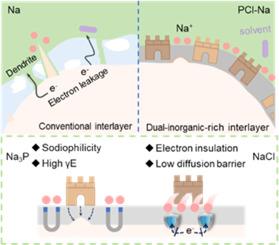Dual-inorganic-rich artificial interphase for sodium metal batteries
IF 14.3
1区 材料科学
Q1 MATERIALS SCIENCE, MULTIDISCIPLINARY
引用次数: 0
Abstract
Sodium metal batteries have gained attention as ideal alternatives to lithium-ion batteries, but the poor compatibility of metallic Na anodes in conventional ester-based electrolytes presents a pivotal challenge. To tackle this issue, a dual-inorganic-rich artificial layer is engineered via the spontaneous reaction of PCl5 with Na, resulting in a Na3P- and NaCl-rich interphase on metallic Na (PCI-Na). In the dual-inorganic-rich interphase, NaCl featuring electronic insulation and a low diffusion barrier can effectively prevent continuous electrolyte decomposition and mitigate the formation of "hot spots" for Na deposition. In addition, Na3P with high interfacial energy and good sodiophilicity helps suppress the dendrite formation and promote uniform sodium plating. As a result, symmetric cells of PCI-Na cycle for nearly 500 h at 1 mA cm−2 and 2 mAh cm−2, outlasting the bare sodium counterpart. Furthermore, when paired with Na3V2(PO4)3, full cells of PCI-Na||Na3V2(PO4)3 cycle stably for 1000 cycles at 5 C, with a capacity retention of 82.3%. The full cells also work well at subzero temperatures, thus indicating that designing dual-inorganic-rich artificial interphase opens up new possibilities for practical sodium metal batteries.

钠金属电池用双富无机人工界面
钠金属电池作为锂离子电池的理想替代品而受到关注,但金属钠阳极在传统酯基电解质中的兼容性差是一个关键挑战。为了解决这一问题,通过PCl5与Na的自发反应,设计了一种双无机富人工层,在金属Na (PCI-Na)上形成一个Na3P和nacl富间相。在双富无机界面中,具有电子绝缘和低扩散势垒特性的NaCl可以有效地阻止电解质的持续分解,减缓Na沉积“热点”的形成。此外,界面能高、亲钠性好的Na3P有助于抑制枝晶的形成,促进均匀镀钠。结果,PCI-Na对称电池在1ma cm - 2和2mah cm - 2下循环近500小时,比裸钠电池的寿命更长。此外,当与Na3V2(PO4)3配对时,PCI-Na||Na3V2(PO4)3的满电池在5℃下稳定循环1000次,容量保持率为82.3%。这种电池在零下温度下也能很好地工作,这表明设计双无机富人工间相为实用的钠金属电池开辟了新的可能性。
本文章由计算机程序翻译,如有差异,请以英文原文为准。
求助全文
约1分钟内获得全文
求助全文
来源期刊

Journal of Materials Science & Technology
工程技术-材料科学:综合
CiteScore
20.00
自引率
11.00%
发文量
995
审稿时长
13 days
期刊介绍:
Journal of Materials Science & Technology strives to promote global collaboration in the field of materials science and technology. It primarily publishes original research papers, invited review articles, letters, research notes, and summaries of scientific achievements. The journal covers a wide range of materials science and technology topics, including metallic materials, inorganic nonmetallic materials, and composite materials.
 求助内容:
求助内容: 应助结果提醒方式:
应助结果提醒方式:


